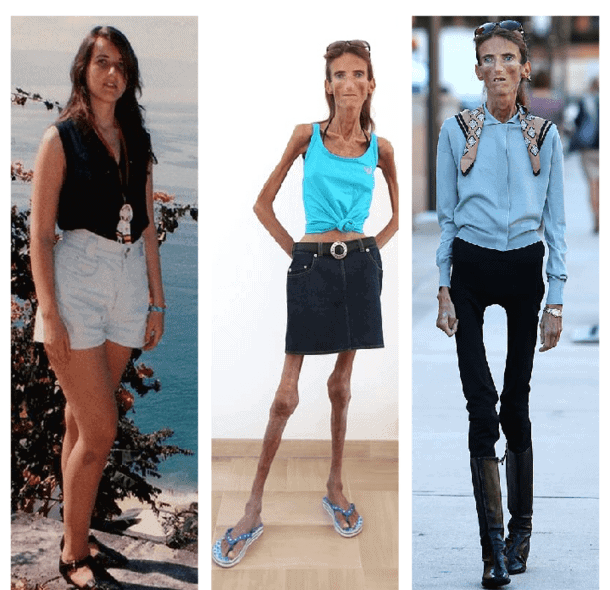Skinniest Person In The World: A Deep Dive Into Extreme Slimness
The concept of the skinniest person in the world has fascinated many, raising questions about human health, genetics, and societal perceptions of body image. This article aims to explore the life and story of the skinniest person in the world, discussing not only their physical attributes but also the implications of extreme thinness on health and well-being. We will delve into the challenges faced by individuals with such extreme body types, the medical conditions associated with them, and the societal pressures that often accompany such a lifestyle.
In a world where body positivity is gaining momentum, the story of the skinniest person in the world serves as a reminder of the diverse range of human bodies and the various health narratives that exist. This discussion will not only spotlight the individual but will also provide valuable insights into the broader issues of health and body image that affect many people today.
As we journey through this article, we will also address the importance of understanding body weight in the context of health rather than mere appearance. Join us as we uncover the story of the skinniest person in the world and the lessons we can learn from their experiences.
Table of Contents
- Biography of the Skinniest Person
- Personal Data and Biodata
- Medical Conditions Associated with Extreme Thinness
- Societal Perceptions of Thinness
- Health Implications of Being Extremely Thin
- Support and Awareness for Individuals
- Conclusion
- References
Biography of the Skinniest Person
The title of the skinniest person in the world is often attributed to various individuals over the years, but one notable figure is **Jonah Falcon**, who has been recognized for his extreme slimness. Born on July 29, 1970, in Brooklyn, New York, Jonah has gained attention not only for his body type but also for his unique life experiences.
Jonah Falcon's Journey
From a young age, Jonah struggled with weight issues, which were compounded by various medical challenges. Despite his attempts to gain weight through diet and exercise, he faced numerous obstacles. Jonah's story serves as a case study in the complexities of body weight and health.
Personal Data and Biodata
| Name | Jonah Falcon |
|---|---|
| Date of Birth | July 29, 1970 |
| Height | 6 ft 1 in (185 cm) |
| Weight | 110 lbs (50 kg) |
| Nationality | American |
Medical Conditions Associated with Extreme Thinness
Extreme thinness can be a result of various medical conditions, including:
- Anorexia Nervosa: A serious eating disorder characterized by self-starvation and excessive weight loss.
- Hyperthyroidism: A condition where the thyroid gland is overactive, leading to rapid weight loss and other health issues.
- Celiac Disease: An autoimmune disorder where the ingestion of gluten leads to damage in the small intestine, often resulting in weight loss.
- Chronic Illnesses: Conditions such as cancer or diabetes can lead to significant weight loss due to metabolic demands.
Societal Perceptions of Thinness
In many cultures, being thin is often equated with beauty and success. This societal pressure can lead to harmful behaviors, including disordered eating and unhealthy lifestyle choices. It's essential to understand that while some individuals may naturally be thin, others may struggle with serious health issues that contribute to their body weight.
The Impact of Media
The media plays a significant role in shaping our perceptions of beauty and body image. The glorification of extreme thinness can create unrealistic standards that many feel pressured to meet. Understanding the complexities behind these images can help foster a more inclusive and accepting view of body diversity.
Health Implications of Being Extremely Thin
While being thin is not inherently unhealthy, extreme thinness can lead to various health risks, including:
- Nutritional Deficiencies: Lack of essential nutrients can lead to severe health problems, including weakened bones and immune function.
- Heart Issues: Being underweight can increase the risk of heart problems due to a lack of necessary body fat.
- Fertility Problems: Extreme thinness can impact reproductive health and hormone levels, leading to fertility issues.
Support and Awareness for Individuals
Raising awareness about the challenges faced by those who are extremely thin is crucial in fostering a supportive environment. Here are some ways to offer support:
- Education: Educate yourself and others about the complexities of body weight and the health implications associated with being underweight.
- Encouragement: Encourage those struggling with body image issues to seek professional help and support.
- Advocacy: Advocate for body positivity and acceptance of all body types, promoting a healthier perspective on beauty.
Conclusion
In conclusion, the story of the skinniest person in the world sheds light on the intricate relationship between body weight, health, and societal perceptions. It is essential to approach the topic of body image with sensitivity and understanding, recognizing that each individual's journey is unique. We must strive to create a world where all body types are accepted and valued. If you found this article informative, please leave a comment, share it with others, and explore more content on our site.
References
For further reading and research on this topic, consider exploring the following sources:
- National Institutes of Health: Medical Conditions Related to Extreme Thinness
- World Health Organization: Obesity and Overweight
- Eating Disorder Hope: Understanding Anorexia Nervosa
Is Caroline Stanbury Jewish? Uncovering The Truth Behind Her Faith
Brad Pitt Plastic Surgery: The Truth Behind The Transformation
Sam Worthington Net Worth 2024: A Comprehensive Overview


